Best Anti-Snoring Devices (MADs and TRDs)
Can’t stop snoring? Check out Counting Sheep’s buyer’s guide and top list for anti-snoring devices and other top stop snoring sleep aids.
Can’t stop snoring? Check out Counting Sheep’s buyer’s guide and top list for anti-snoring devices and other top stop snoring sleep aids.
Given that the supplied text consists solely of a non-breaking space entity ( ), there’s essentially no substantive content to reinterpret while preserving its initial sentiment and meaning. Should you have particular text you wish rephrased, kindly submit it for support.
According to the research carried out by the American Academy of Otorhinolaryngology, 45% of adults in the US occasionally snore, while 25% are habitual snorers. This problem is more frequent in males and gets worse with age. Snoring can be a symptom of severe health issues such as sleep apnea. Most snorers find relief by using anti-snoring mouthpieces, also known as mouthguards. Mouthguards reduce snoring by holding the tongue in place or pushing the jaw forward. These devices are divided into two categories – MADs (mandibular advancement devices) and TRDs (tongue retaining devices). Mandibular advancement devices move the lower jaw forward, while tongue retaining devices, as the name suggests, hold the tongue in place and prevent air blockage.
If you are thinking about buying a mouthguard, there are certain things you should consider. MADs are created individually and molded to the user’s teeth. However, although they are customizable, and can be adjusted, they may cause physical discomfort. TRDs are cheaper and cause less discomfort, but their one-size-fits-all design may not be suitable for some users. Below, you will find our top 5 anti-snoring devices available today. Our choices are based on careful product research and analysis, as well as customer experiences. In order to create this guide, we have consulted with 5 sleep experts and conducted more than 120 hours of research.
Highlights: plastic, non-adjustable, universal design, 30-night sleep trial
As mentioned above, most MADs are molded to the user’s mouth. However, the ZQuiet comes with a universal design that automatically adjusts to the user’s mouth. This is done by using a hinged design which eliminates the need to push the jaw forward and therefore prevents pain or discomfort typically caused by standard MADs.
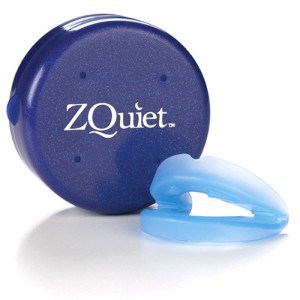
Unlike some restrictive mandibular advancement devices, the ZQuiet allows users to breathe both through their nose and mouth. The special design of the product also eases the process of opening and closing the mouth, as well as moving the jaw side to side. Lastly, this product is very budget-friendly. The price is affordable and comes with a backed by a 30-night sleep trial. The product was designed by a dentist, and it’s FDA approved.
Recommended for:
Highlights: plastic, non-adjustable, universal design, 30-night sleep trial
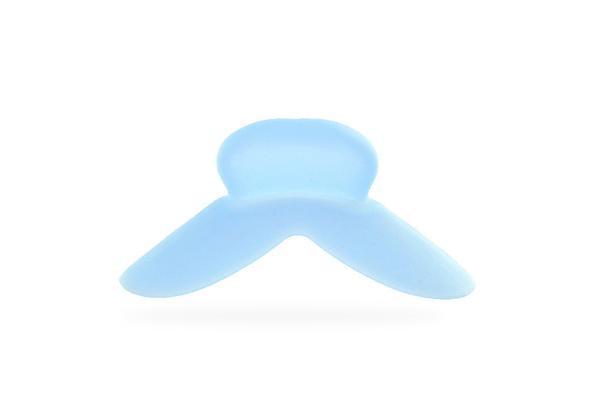
The Good Morning Snore Solution is a small, lightweight tongue retaining device that effectively stabilizes the tongue and therefore reduces snoring. The device has a universal size, but it’s compact enough to accommodate most mouth sizes. The shape of the mouthguard also allows it to be cleaned easily. You don’t need a doctor’s prescription to buy the Good Morning Snore Solution. The only downside is that this anti snoring device is a bit pricey. However, it is possible to get two devices at a discounted rate as part of a bundle package. Good news is that in case you are not satisfied, the Good Morning Snore Solution is backed by a 30-night guarantee with full refunds.
Recommended for:
Highlights: plastic, adjustable, customized fit, 60-night sleep trial, 1-year warranty
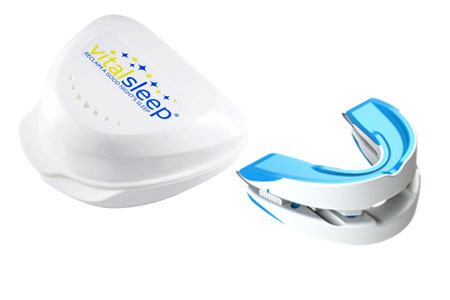
VitalSleep anti-snoring mouthpiece is very affordable and comes with a customizable fit and can easily be adjusted to the shape and size of the user’s mouth. It can be adjusted by an allen wrench that is included in the purchase. For added customization, this product comes in a larger men’s size and smaller women’s size. In case the size doesn’t fit, the company offers free exchanges.
When VitalSleep is properly molded, the person wearing it can sleep in any position and breathe through their nose and mouth. In case the user is not satisfied, this product comes with a 60-night sleep trial and full refund guarantee. It’s also worth mentioning that VitalSleep is backed up with 1-year warranty. Most anti-snoring devices do not have any kind of warranty.
Recommended for:
Highlights: silicone, non-adjustable, universal size, prescription required
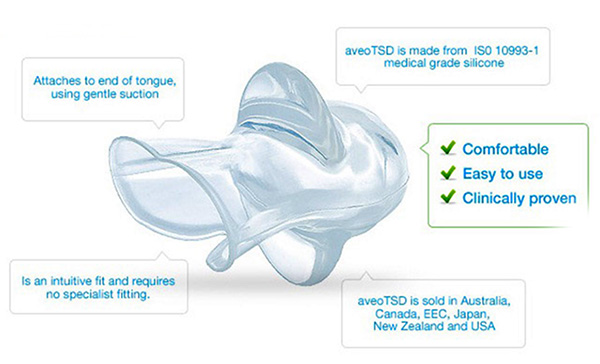
The AVEOtsd is a lightweight tongue retaining device made from silicone and may be much comfortable and easier to wear than plastic. This device is specially designed not to advance the jaw, but to stabilize the tongue with its gentle suction system. The AVEOtsd keeps the tongue firmly between the upper and lower teeth and doesn’t cause any pain or discomfort. It comes in three sizes – small, medium and large. The majority of consumers opt for medium size. The advantage of this mouthpiece is that it never has to be adjusted or customized and doesn’t contain any moving parts. It’s very easy to clean and maintain. However, in order to get it, you need a doctor’s or a dentist’s prescription. The AVEOtsd is more affordable than other TRD devices, and it’s a high-value option for people with snoring problems.
Recommended for:
Highlights: plastic, adjustable, customized fit, 30-night sleep trial
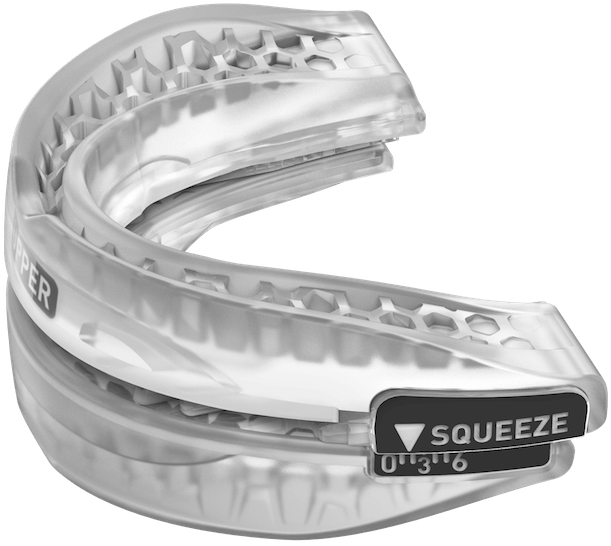
The SnoreRx is an anti-snore device sleep aid that comes with an eye-catching design and a calibrator on each side to aid with adjustments. The mouthpiece can be adjusted up to 6 millimeters in 1mm increments, making it perfect for sleepers with different jaw advancement preferences. The Snore rx can be adjusted manually at any time in a very simple way. You just need to squeeze its sides to slide the upper and lower trays. The mouthpiece comes with a price that is significantly more affordable than other ‘bite-and-boil’ mouthpieces with a customized fit. Unlike most MAD devices, it doesn’t require a doctor’s or a dentist’s prescription. The product is backed up with a 30-night sleep trial and comes with a full refund.
Recommended for:
As mentioned in the beginning, according to the research carried out by the American Academy of Otorhinolaryngology, 45% of adults in the US snore occasionally, while 25% are habitual snorers. Young adults aged 18-24 years are 25% less likely to snore than older adults. Snoring is more likely to occur to men, and it gets worse with age. There are no proven ways to cure snoring, and most individuals (and their partners) find relief by using anti-snoring devices. These simple devices suppress snoring either by pushing down the tongue or advancing the jaw forward. Most anti-snoring mouthpieces don’t require a doctor’s or a dentist’s prescription and come with an affordable price of $100 or less. Before buying an anti-snoring device, you should learn more about this sleep related condition, as well as how anti-snoring treatments and technology works. We will also cover some considerations you should have in mind when purchasing a mouthguard. Lastly, this guide will also cover our top picks.
We start snoring when the upper airway is restricted. The restriction of upper airway causes a tickling sensation at the back of the throat which as a result produces a harsh and often loud, gurgling sound. Snoring can be caused by multiple factors, starting from obesity to consumption of alcohol or antidepressants. Obesity or being overweight is one of the leading causes of snoring. Excessive skin and fat around one’s throat restricts the circulation in the airway and causes snoring. Cold or allergy related congestion can also cause snoring. Lastly, snoring can be caused due to the consumption of alcohol or antidepressants which make the throat relax.
It is also important to mention that most adults snore due to obstructive sleep apnea (OSA). Obstructive sleep apnea is a sleep disorder characterized by temporary loss of breath during sleep. OSA, as the name suggests, is caused by a physical obstruction in the airway that impairs normal breathing. Due to the condition, the sleeper may experience dozens of breathing-loss episodes per night. Apart from OSA, snoring can also be caused by central sleep apnea. CSA occurs when the brain is unable to send proper signals to the muscles that control breathing, and as a result, causes snoring. Sleep apnea is a condition that should be taken seriously because it increases the risk of severe health conditions such as stroke, heart disease, and diabetes.
Unfortunately, there is still no known cure for sleep apnea. Sleep apnea treatment includes using CPAP machines which deliver a steady stream of air to the user, or BiPAP machines which deliver air at variable pressurization rates based on the user’s breathing patterns. Continuous positive airway pressure machines alleviate the symptoms of OSA, while bi-level positive airway pressure machines are mostly used to relieve central sleep apnea symptoms. These machines are very effective in eliminating the breathing-loss episodes that occur due to sleep apnea. However, they are often expensive ($200 is the base price) and require a doctor’s prescription.
Anti-snoring sleep aids can also be used to alleviate sleep apnea, and they are a more cost-effective option that CPAP and BiPAP machines. Anti-snoring mouthpieces are also a hassle-free alternative to standard sleep apnea treatment. These devices should if not stop snoring immediatelly, at least reduce or fix loud snoring.
Stop snoring devices reduce snoring by creating a physical barrier between the soft, vibrating tissues in your mouth and the throat. These mouthpieces and mouthguards can be divided into two categories – MADs (mandibular advancement devices) and TRDs (tongue retaining devices).
MADs reduce snoring by moving the lower jaw forward and expanding the airway. The mouthpiece presses down the tongue and breathing muscles attached to the mandible. Typically, mandibular advancement devices are molded to the user’s teeth, and many of them come with an adjustable lower tray that can be moved forward or backward. Some products are specially designed to be used with CPAP/BiPAP machines. Mandibular advancement devices are designed to do the following:
TRDs don’t push the mandible forward but reduce snoring by stabilizing the tongue. Tongue retaining devices expand the gap between the tongue and the back of the throat by pulling the tongue forward. TRDs usually look like clear pacifiers. The tongue fits into an opening at the front, and creates gentle suction that pulls it down and away from the back of the throat. These products don’t require molding according to the user’s teeth and mouth. Most of them come in one size.
| ANTI-SNORING DEVICE TYPE | MANDIBULAR ADVANCEMENT DEVICE (MAD) |
TONGUE RETAINING DEVICE (TRD) |
| Function | Mandible advancement to expand the airway | Isolates tongue from the throat to expand the airway |
| Sizing | Molded or fitted to the user’s teeth |
Universal size |
| Adjustment | Has adjustable lower trays |
Mostly not adjustable |
| Material | Silicone or plastic | Silicone or plastic |
| Breathing function | Allows free breathing through the mouth |
Some models can have tiny holes for mouth breathing |
| Side effects | Jaw discomfort Excessive drooling Dry mouth Tooth pain |
Excessive drooling Dry mouth |
| Additional features | Bruxism aid | Denture-friendly |
| Expected lifespan | Two years or less | Two years or less |
| Average cost | $75 to $150 | $100 or less |
In order to meet the standard requirements for medical devices sold in the US, all MAD and TRD pieces must undergo rigorous evaluations and certifications. Before buying a specific MAD and TRD mouthpiece, it is advised to research the certification status of the product. Although some anti-snoring devices can be purchased without a doctor’s prescription, it’s recommended not to use these anti-snoring aids without an approval from your physician. In case snoring persists despite regular use of an anti-snoring mouthpiece, you should also consult with your doctor.
The biggest benefits of using these devices compared to CPAP or BiPAP machines are low price, non-invasive treatment, no noise, and low maintenance requirements. Let’s take a closer look.
One of the biggest benefits of using a stop snoring aid is a low-cost investment. When it comes to price, CPAP or BiPAP machines have a base price of $200, and the starting price of standard MAD or TRD models is only $40. Keep in mind that custom mouthguards can be costly, but compared to CPAP or BiPAP machines, they are still more affordable.
MAD and TRD mouthpieces do not require the user to undergo a medical procedure, and most of them don’t require a prescription. Anti-snoring devices are an effective sleep aid, but unfortunately, they don’t work for all people. If you are one of the few that doesn’t get the desired results, it is good to know that you won’t lose your money. Most companies, such as SnoreRx and ZQuiet that sell anti-snoring mouthpieces offer a full refund in case you are not satisfied.
Sometimes, the only solution for snoring may be surgery. However, before opting for such invasive treatment, it is better to try at least if some of the non-invasive options help you. Anti-snore devices are entirely safe to use. It is also worth mentioning that an invasive procedure may lead to a variety of side-effects.
The main benefit of using anti-snore devices is that you can always return the product to the seller, and basically try and fail until you find a method that works for your problem. However, this isn’t the case with invasive solutions like surgery, and what is once done cannot be undone. Possible errors or results may have permanent consequences on your lifestyle and health.
Unlike CPAP and BiPAP machines which are quite loud, anti-snoring mouthguards produce no noise when being used.
Lastly, both MADs and TRDs are very easy to clean and maintain. After every use, all you need to do is to place them in hot water to sterilize the device against germs and bacteria. Also, these devices should be stored in a protective case.
Unlike CPAP and BiPAP machines, stop snoring devices are very easy to carry. All anti-snoring mouthpieces are portable and come with their own case. They are small and lightweight which is also ideal for traveling. In case you are traveling through security in an airport, bulky CPAP and BiPAP machines may trigger a TSA inspection. Of course, convenience is not the most critical factor when deciding your health, but if you frequently travel (for example for work), this may be an important consideration.
As you undoubtedly know, there is nothing better for your health than getting a good night’s sleep. If you have sleep apnea or frequently snore, the quality of your sleep will be disrupted. Waking up refreshed and full of energy is priceless, and anti-snoring devices may sometimes be the solution to get more sleep and wake up every morning revitalized.
Many studies have warned us that a chronic lack of sleep can have severe consequences on our health. For example, chronic sleep deprivation may affect your memory capacity, lead to hormonal imbalances and weight gain, and much more. By using a stop snoring aid and improving the quality your sleep, you will also make a positive effect on your overall health. Keep in mind that lack of sleep may make you irritable and more prone to make personal or work-related accidents.
Although these products don’t cause the same level of discomfort as CPAP and BiPAP therapy, MADs and TRDs may cause some physical discomfort, and side effects such as dry mouth and excessive salivation, jaw pain and stiffness.
It is also important to keep in mind that MADs and TRDs are specifically designed to reduce snoring and not to tackle any other symptoms of sleep apnea. Therefore, when it comes to OSA or CSA treatment, CPAP and BiPAP machines are much more effective. Compared to these machines, most anti-snoring mouthpieces have a short life span, because they are designed to be used from six months to two years.
Here are some factors you should keep in mind before shopping for an anti-snoring device. The following section should help you compare brands and different models easier.
The first thing you should consider before shopping is if the device is a MAD or a TRD. The choice between the two comes down to your own preferences. If you prefer adjustable mouthpieces, you will most likely opt for a MAD, and if you are looking for a universal size, you will most likely select a TRD model. MADs adjustment rate can sometimes be very specific (for example, from one millimeter to one-sixteenth of an inch. However, there are also some models that don’t mention a specific level of adjustment. Lastly, some products even come with a calibrator that displays the current settings and can be reset to the original settings.
Standard anti-snoring devices are available for $100 or less. However, custom devices can be costly and cost $2,000 or more. If the customized fitting is important to you, it’s better to select a MAD that a one-size-fits-all TRD.
Many people with dentures also have problems with sleep apnea. Oral appliance therapy such as MADs can be used to treat sleep apnea and snoring, but the process is rather complicated. The biggest problem for snorers with dentures is that they have no natural attachment points for an oral appliance. However, MADs can be made to work for patients with dentures if they attach with dental implants.
Since sleep apnea is more common among elderly patients, many snorers may already have implants in place. To properly use MADs, they simply need to remove their denture as normal, and replace them with a mandibular retaining device.
When it comes to TRDs, things are not that complicated. Actually, the process is very simple. Since TRDs resemble pacifiers and don’t require attaching the device to the user’s teeth, they can be worn easily by patients with dentures.
If you prefer breathing through your mouth while sleeping, MADs may be more suitable for you than tongue retaining devices because most models allow you to freely open and close your mouth, move your jaw and similar. Some tongue retaining devices come with tiny holes that allow mouth breathing, but other models may be problematic. Although some TRDs come with perforated holes, some users still find them uncomfortable for mouth breathing.
Bruxism can be caused due to many different reasons. However, this condition can often be found in patients suffering from sleep apnea. Researchers believe that teeth grinding in sleep apnea patients occur as an unconscious response to the collapsed airways. By tightening the jaw muscles, you actually unconsciously prevent restrictions of airflow. Good news is that by using MADs, you can treat bruxism and reduce snoring at the same time. MADs have been shown to be effective in treating bruxism no matter whether or not it is caused by obstructive sleep apnea. TRDs cannot be used to treat or prevent teeth grinding.
These devices are very effective for reducing or completely eliminating snoring. However, when it comes to sleep apnea snoring, this type of device may not suffice. For sleep apnea related snoring, it’s best to use a CPAP or BiPAP machine. Anti-snoring mouthguards, as the name suggests reduce snoring, and are not able to target other sleep apnea issues such as nighttime loss of breath.
Generally speaking, lower priced models and those that have a simple design do not require a prescription. However, more advanced and expensive devices may require a prescription. Before purchasing a model, it is best to research all the requirements carefully, and to consult with your doctor. Based on you’re the cause of your snoring, your doctor may help you select the best anti-snoring device on the market.
Some anti-snoring devices come with a trial period, meaning you can return the product within a specific timeframe if you are not satisfied with it. Most trials last from 30 to 90 days.
Before purchasing a model, we encourage you to check whether or not the device was certified. In most cases, the certification status of the product can be seen on its packaging or the official website of the company.
If a mandibular advancement device or a tongue retaining device cannot reduce your snoring, here are some other stop snoring products, snoring remedies that work as well as strategies and accessories you can use:
We mentioned before that CPAP and BiPAP machines are very effective at reducing the symptoms of sleep apnea and snoring. However, this type of treatment may be expensive and uncomfortable to use. Also, you need a doctor’s prescription in order to get one. Another problem is that is you are sharing a bed with someone; they may be bothered by the noise the machine makes. Here are some of the critical details about CPAP and BiPAP machines, and how they alleviate the symptoms of sleep apnea and reduce snoring.
CPAP machine is a continuous positive air pressure device that is designed to treat obstructive sleep apnea. It works by increasing the positive air pressure until its prescribed rate, therefore allowing continuous and undisrupted breathing. Average price goes from $200 to $800.
Bi-level positive air pressure devices are specifically designed to treat central sleep apnea. These devices work by increasing and decreasing pressure at variable rates, depending on the user’s breathing. The average price goes from $800 to $1,700.
If anti-snoring mouthpieces don’t help you and CPAP/BiPAP machines are too loud too expensive for your budget, you may opt for a simpler sleep apnea treatment such as non-mask devices. One example of such devices is Provent. Provent is FDA-approved sleep apnea treatment, and it was introduced by researchers at Stanford University. The Provent features two disposable devices with air filters that are placed inside both nostrils and doesn’t include using a sleep mask or hooking yourself up to a generator. Before opting for such a device, it’s vital to consult with your doctor.
If you have sleep apnea, you should avoid sleeping on your back with your head elevated. To reduce snoring, consider getting a pillow that will put your head and neck in a more comfortable position. Pillow thickness generally has three categories – high, medium or low. Pillow thickness is also referred as pillow loft. High-loft means the pillow is thicker than five inches, medium-loft means it’s thicker than three inches, and low-loft means the pillow is thinner than three inches. When it comes to selecting the right pillow thickness for yourself, you should have the following factors in mind.
If you are a bit heavy, low loft pillows will be more suitable for you. Heavy people sink into their mattress and a low loft the pillow will create a nice barrier between your head and the sleep surface. If you are more light-weight, high-loft pillows may be more suitable because you do not sink deeply into your bed.
If your head is larger than average, a high-loft pillow will provide excellent support. When your head size is average or below average, you will find more comfortable using pillows with medium or low thickness.
Higher-loft pillows are usually needed for people with broader shoulders, while people with narrow shoulders usually receive enough support from pillows of medium or low thickness.
If you have a soft mattress, you will also prefer using a low loft pillow. A high loft pillow will create an unnecessary large barrier between your head and sleeping surface. However, if you have a firm mattress, thicker pillows may provide better cushioning and support.
If you have a problem with snoring, anti snore adjustable beds may help because they enable you to customize the angle of the mattress at the head and sometimes also at the foot. Lifting the upper part of your bed a bit may reduce snoring and allow you to sleep with less disruption. It’s worth mentioning that some adjustable beds come with anti-snore features, and are specifically designed for snorers.
Most adjustable beds also have remote or app-based controls, and can support at least 600 pounds. However, you should know that these beds are quite expensive and the average price point is from $1,000 to $3,000.
A wannabe journalist who somehow ended up as an art historian. She is a gamer, a coffee addict and a sleep aficionado. When she is not researching about sleep and finding out new ways to fight off the insomnia beast, she's spending time with her friends, gaming or visiting local museums.